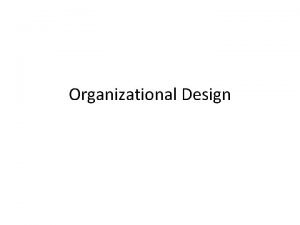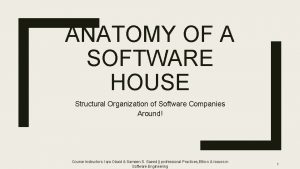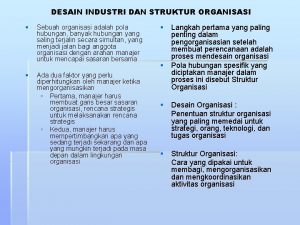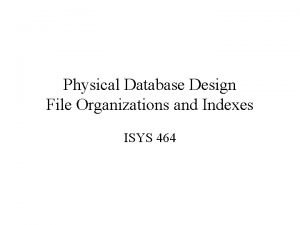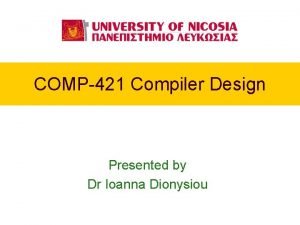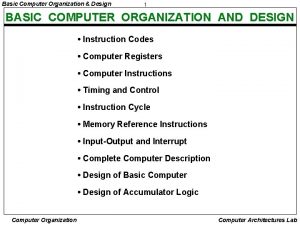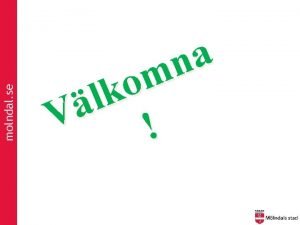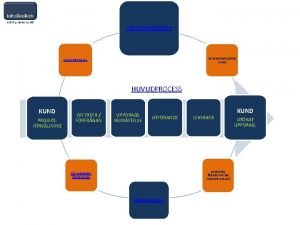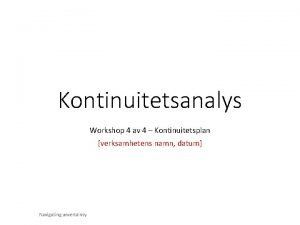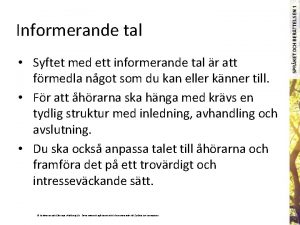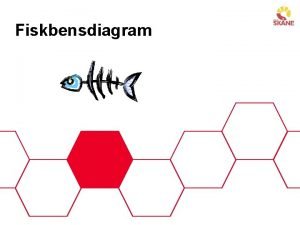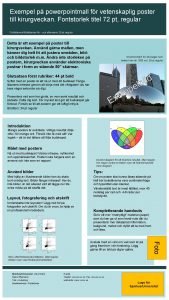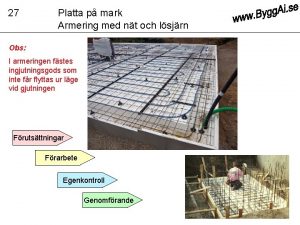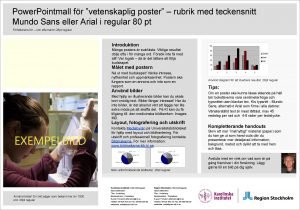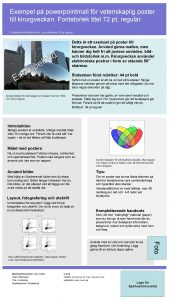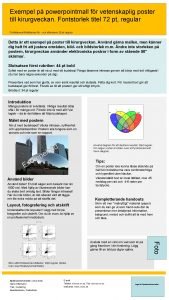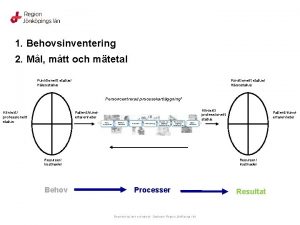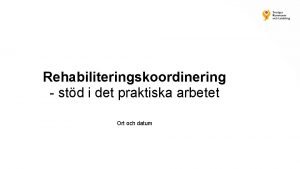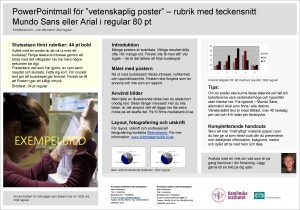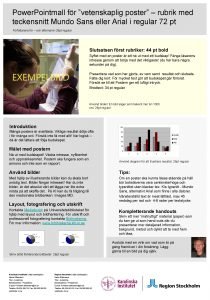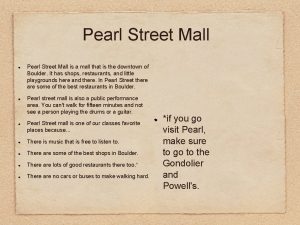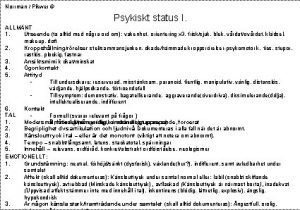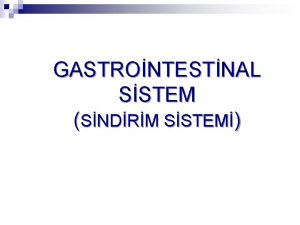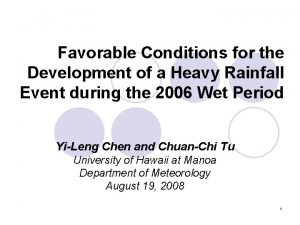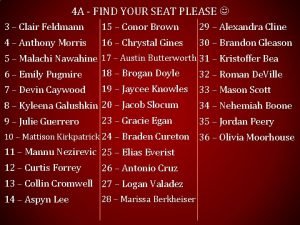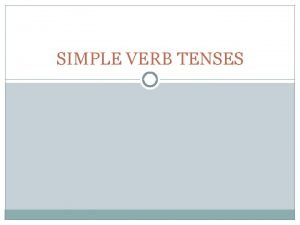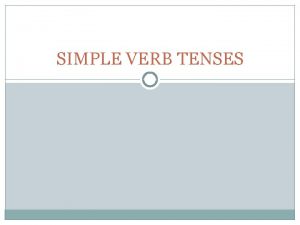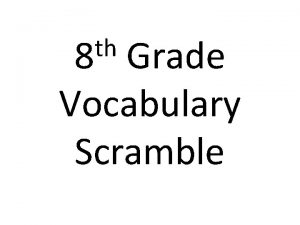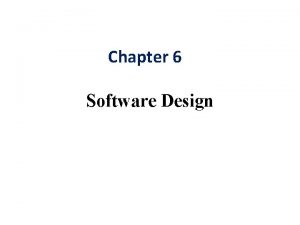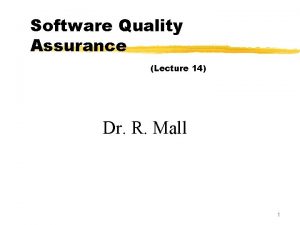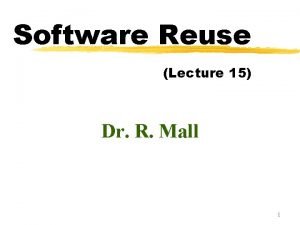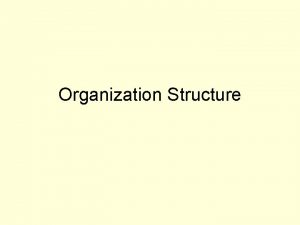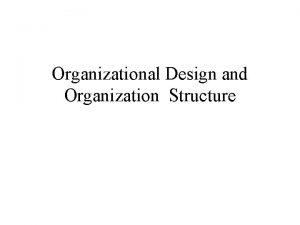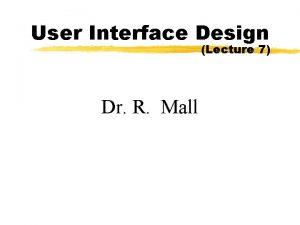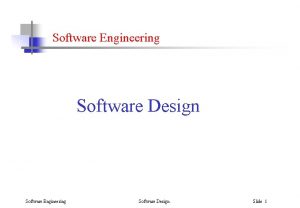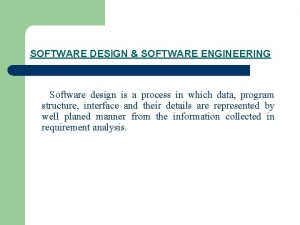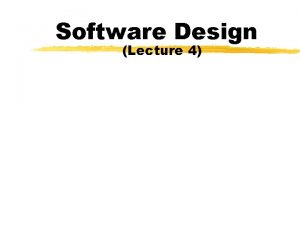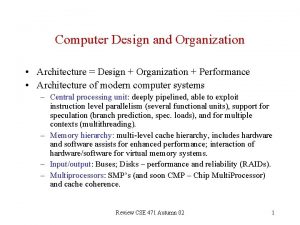Software Design Lecture 4 Dr R Mall Organization


































































































- Slides: 98

Software Design (Lecture 4) Dr. R. Mall

Organization of this Lecture Ñ Brief review of previous lectures Ñ Introduction to software design Ñ Goodness of a design Ñ Functional Independence Ñ Cohesion and Coupling Ñ Function-oriented design vs. Objectoriented design Ñ Summary

Review of previous lectures ÑIntroduction to software engineering ÑLife cycle models ÑRequirements Analysis and Specification: y Requirements gathering and analysis y Requirements specification

Introduction Ñ Design phase transforms SRS document: y into a form easily implementable in some programming language. SRS Document Design Activities Design Documents

Introduction Ñ Items designed: y module structure, y control relationship among the modules x call relationship or invocation relationship y interface among different modules, x data items to be exchanged among different modules, y data structures of individual modules, y algorithms for individual modules.

Module Structure

Introduction Ñ A module consists of: y several functions y associated data structures. D 1. . D 2. . D 3. . F 1. . F 2. . F 3. . F 4. . F 5. . Data Functions

Introduction ÑGood software designs: y seldom arrived through a single step procedure: y but through a series of steps and iterations.

Introduction Ñ Design activities are usually classified into two stages: y preliminary (or high-level) design y detailed design. Ñ Meaning and scope of the two stages: y vary considerably from one methodology to another.

High-level design Ñ Identify: y modules y control relationships among modules y interfaces among modules. d 2 d 1 d 3 d 1 d 4

High-level design ÑThe outcome of high-level design: y program structure (or software architecture).

High-level Design ÑSeveral notations are available to represent high-level design: y Usually a tree-like diagram called structure chart is used. y Other notations: x. Jackson diagram or Warnier-Orr diagram can also be used.

Detailed design ÑFor each module, design: y data structure y algorithms ÑOutcome of detailed design: y module specification.

A fundamental question: ÑHow to distinguish between good and bad designs? y Unless we know what a good software design is: xwe can not possibly design one.

Good and bad designs Ñ There is no unique way to design a system. Ñ Even using the same design methodology: y different engineers can arrive at very different design solutions. Ñ We need to distinguish between good and bad designs.

What Is Good Software Design? ÑShould implement all functionalities of the system correctly. ÑShould be easily understandable. ÑShould be efficient. ÑShould be easily amenable to change, y i. e. easily maintainable.

What Is Good Software Design? ÑUnderstandability of a design is a major issue: y determines goodness of design: y a design that is easy to understand: x also easy to maintain and change.

What Is Good Software Design? Ñ Unless a design is easy to understand, y tremendous effort needed to maintain it y We already know that about 60% effort is spent in maintenance. Ñ If the software is not easy to understand: y maintenance effort would increase many times.

Understandability Ñ Use consistent and meaningful names y for various design components, Ñ Design solution should consist of: y a cleanly decomposed set of modules (modularity), Ñ Different modules should be neatly arranged in a hierarchy: y in a neat tree-like diagram.

Modularity Ñ Modularity is a fundamental attributes of any good design. y Decomposition of a problem cleanly into modules: y Modules are almost independent of each other y divide and conquer principle.

Modularity Ñ If modules are independent of each other: y modules can be understood separately, x reduces the complexity greatly. y To understand why this is so, x remember that it is very difficult to break a bunch of sticks but very easy to break the sticks individually.

Example of Cleanly and Noncleanly Decomposed Modules

Modularity Ñ In technical terms, modules should display: y high cohesion y low coupling. Ñ We will shortly discuss: y cohesion and coupling.

Modularity ÑNeat arrangement of modules in a hierarchy means: y low fan-out y abstraction

Cohesion and Coupling Ñ Cohesion is a measure of: y functional strength of a module. y A cohesive module performs a single task or function. Ñ Coupling between two modules: y a measure of the degree of interdependence or interaction between the two modules.

Cohesion and Coupling ÑA module having high cohesion and low coupling: y functionally independent of other modules: x A functionally independent module has minimal interaction with other modules.

Advantages of Functional Independence Ñ Functional independence is key to: y understandability and good design: y Complexity of design is reduced, y different modules can be understood in isolation: x modules are more or less independent of each other.

Advantages of Functional Independence Ñ Functional independence reduces error propagation. y degree of interaction between modules is low. y an error existing in one module does not directly affect other modules. Ñ Reuse of modules is possible.

Advantages of Functional Independence Ñ A functionally independent module: y can be easily taken out and reused in a different program. x each module does some well-defined and precise function x the interfaces of a module with other modules is simple and minimal.

Functional Independence Ñ Unfortunately, there are no ways: y to quantitatively measure the degree of cohesion and coupling: y classification of different kinds of cohesion and coupling: x will give us some idea regarding the degree of cohesiveness of a module.

Classification of Cohesiveness Ñ Classification is often subjective: y yet gives us some idea about cohesiveness of a module. Ñ By examining the type of cohesion exhibited by a module: y we can roughly tell whether it displays high cohesion or low cohesion.

Classification of Cohesiveness functional sequential communicational procedural temporal logical coincidental Degree of cohesion

Coincidental cohesion Ñ The module performs a set of tasks: y which relate to each other very loosely, if at all. x the module contains a random collection of functions. x functions have been put in the module out of pure coincidence without any thought or design.

Logical cohesion Ñ All elements of the module perform similar operations: y e. g. error handling, data input, data output, etc. Ñ An example of logical cohesion: y a set of print functions to generate an output report arranged into a single module.

Temporal cohesion Ñ The module contains tasks that are related by the fact: y all the tasks must be executed in the same time span. Ñ Example: y The set of functions responsible for x initialization, x start-up, shut-down of some process, etc.

Procedural cohesion ÑThe set of functions of the module: y all part of a procedure (algorithm) y certain sequence of steps have to be carried out in a certain order for achieving an objective, x e. g. the algorithm for decoding a message.

Communicational cohesion Ñ All functions of the module: y reference or update the same data structure, Ñ Example: y the set of functions defined on an array or a stack.

Sequential cohesion Ñ Elements of a module form different parts of a sequence, y output from one element of the sequence is input to the next. y Example: sort search display

Functional cohesion Ñ Different elements of a module cooperate: y to achieve a single function, y e. g. managing an employee's pay-roll. Ñ When a module displays functional cohesion, y we can describe the function using a single sentence.

Determining Cohesiveness Ñ Write down a sentence to describe the function of the module y If the sentence is compound, x it has a sequential or communicational cohesion. y If it has words like “first”, “next”, “after”, “then”, etc. x it has sequential or temporal cohesion. y If it has words like initialize, x it probably has temporal cohesion.

Coupling Ñ Coupling indicates: y how closely two modules interact or how interdependent they are. y The degree of coupling between two modules depends on their interface complexity.

Coupling Ñ There are no ways to precisely determine coupling between two modules: y classification of different types of coupling will help us to approximately estimate the degree of coupling between two modules. Ñ Five types of coupling can exist between any two modules.

Classes of coupling data stamp control common content Degree of coupling

Data coupling ÑTwo modules are data coupled, y if they communicate via a parameter: x an elementary data item, x e. g an integer, a float, a character, etc. y The data item should be problem related: x not used for control purpose.

Stamp coupling ÑTwo modules are stamp coupled, y if they communicate via a composite data item x such as a record in PASCAL x or a structure in C.

Control coupling ÑData from one module is used to direct y order of instruction execution in another. ÑExample of control coupling: y a flag set in one module and tested in another module.

Common Coupling ÑTwo modules are common coupled, y if they share some global data.

Content coupling Ñ Content coupling exists between two modules: y if they share code, y e. g, branching from one module into another module. Ñ The degree of coupling increases y from data coupling to content coupling.

Neat Hierarchy Ñ Control hierarchy represents: y organization of modules. y control hierarchy is also called program structure. Ñ Most common notation: y a tree-like diagram called structure chart.

Neat Arrangement of modules ÑEssentially means: y low fan-out y abstraction

Characteristics of Module Structure Ñ Depth: y number of levels of control Ñ Width: y overall span of control. Ñ Fan-out: y a measure of the number of modules directly controlled by given module.

Characteristics of Module Structure Ñ Fan-in: y indicates how many modules directly invoke a given module. y High fan-in represents code reuse and is in general encouraged.

Module Structure Fan out=2 Fan out=1 Fan in=2 Fan out=0

Goodness of Design ÑA design having modules: y with high fan-out numbers is not a good design: y a module having high fan-out lacks cohesion.

Goodness of Design Ñ A module that invokes a large number of other modules: y likely to implement several different functions: y not likely to perform a single cohesive function.

Control Relationships Ñ A module that controls another module: y said to be superordinate to it. Ñ Conversely, a module controlled by another module: y said to be subordinate to it.

Control Relationships Ñ Control hierarchy also represents another characteristics: y visibility. Ñ A module A is said to be visible by another module B, y if A directly or indirectly calls B.

Bad Design

Abstraction Ñ Lower-level modules: y do input/output and other low-level functions. Ñ Upper-level modules: y do more managerial functions.

Abstraction ÑThe principle of abstraction requires: y lower-level modules do not invoke functions of higher level modules. y Also known as layered design.

High-level Design Ñ High-level design maps functions into modules {fi} {mj} such that: y Each module has high cohesion y Coupling among modules is as low as possible y Modules are organized in a neat hierarchy

High-level Design • f 1 • f 2 • f 3 • • fn d 2 d 1 d 3 d 1 d 4

Design Approaches ÑTwo fundamentally different software design approaches: y Function-oriented design y Object-oriented design

Design Approaches ÑThese two design approaches are radically different. y However, are complementary x rather than competing techniques. y Each technique is applicable at x different stages of the design process.

Function-Oriented Design Ñ A system is looked upon as something y that performs a set of functions. Ñ Starting at this high-level view of the system: y each function is successively refined into more detailed functions. y Functions are mapped to a module structure.

Example Ñ The function create-new-library- member: y creates the record for a new member, y assigns a unique membership number y prints a bill towards the membership

Example Ñ Create-library-member function consists of the following sub-functions: y assign-membership-number y create-member-record y print-bill

Function-Oriented Design Ñ Each subfunction: y split into more detailed subfunctions and so on.

Function-Oriented Design ÑThe system state is centralized: y accessible to different functions, y member-records: x available for reference and updation to several functions: · create-new-member · delete-member · update-member-record

Function-Oriented Design Ñ Several function-oriented design approaches have been developed: y y y Structured design (Constantine and Yourdon, 1979) Jackson's structured design (Jackson, 1975) Warnier-Orr methodology Wirth's step-wise refinement Hatley and Pirbhai's Methodology

Object-Oriented Design Ñ System is viewed as a collection of objects (i. e. entities). Ñ System state is decentralized among the objects: y each object manages its own state information.

Object-Oriented Design Example ÑLibrary Automation Software: y each library member is a separate object x with its own data and functions. y Functions defined for one object: x cannot directly refer to or change data of other objects.

Object-Oriented Design Ñ Objects have their own internal data: y defines their state. Ñ Similar objects constitute a class. y each object is a member of some class. Ñ Classes may inherit features y from a super class. Ñ Conceptually, objects communicate by message passing.

Object-Oriented versus Function. Oriented Design Ñ Unlike function-oriented design, y in OOD the basic abstraction is not functions such as “sort”, “display”, “track”, etc. , y but real-world entities such as “employee”, “picture”, “machine”, “radar system”, etc.

Object-Oriented versus Function. Oriented Design Ñ In OOD: y software is not developed by designing functions such as: x update-employee-record, x get-employee-address, etc. y but by designing objects such as: x employees, x departments, etc.

Object-Oriented versus Function. Oriented Design ÑGrady Booch sums up this fundamental difference saying: y “Identify verbs if you are after procedural design and nouns if you are after object-oriented design. ”

Object-Oriented versus Function. Oriented Design ÑIn OOD: y state information is not shared in a centralized data. y but is distributed among the objects of the system.

Example: Ñ In an employee pay-roll system, the following can be global data: y names of the employees, y their code numbers, y basic salaries, etc. Ñ Whereas, in object oriented systems: y data is distributed among different employee objects of the system.

Object-Oriented versus Function. Oriented Design ÑObjects communicate by message passing. y one object may discover the state information of another object by interrogating it.

Object-Oriented versus Function. Oriented Design Ñ Of course, somewhere or other the functions must be implemented: y the functions are usually associated with specific real-world entities (objects) y directly access only part of the system state information.

Object-Oriented versus Function. Oriented Design Ñ Function-oriented techniques group functions together if: y as a group, they constitute a higher level function. Ñ On the other hand, object-oriented techniques group functions together: y on the basis of the data they operate on.

Object-Oriented versus Function. Oriented Design Ñ To illustrate the differences between object -oriented and function-oriented design approaches, y let us consider an example --y An automated fire-alarm system for a large building.

Fire-Alarm System: Ñ We need to develop a computerized fire alarm system for a large multi-storied building: y There are 80 floors and 1000 rooms in the building.

Fire-Alarm System: Ñ Different rooms of the building: y fitted with smoke detectors and fire alarms. Ñ The fire alarm system would monitor: y status of the smoke detectors.

Fire-Alarm System ÑWhenever a fire condition is reported by any smoke detector: y the fire alarm system should: x determine the location from which the fire condition was reported x sound the alarms in the neighboring locations.

Fire-Alarm System ÑThe fire alarm system should: y flash an alarm message on the computer console: x fire fighting personnel man the console round the clock.

Fire-Alarm System Ñ After a fire condition has been successfully handled, y the fire alarm system should let fire fighting personnel reset the alarms.

Function-Oriented Approach: Ñ /* Global data (system state) accessible by various functions */ BOOL detector_status[1000]; int detector_locs[1000]; BOOL alarm-status[1000]; /* alarm activated when status set */ int alarm_locs[1000]; /* room number where alarm is located */ int neighbor-alarms[1000][10]; /* each detector has at most */ /* 10 neighboring alarm locations */ The functions which operate on the system state: interrogate_detectors(); get_detector_location(); determine_neighbor(); ring_alarm(); reset_alarm(); report_fire_location();

Object-Oriented Approach: Ñ class detector Ñ attributes: status, location, neighbors Ñ operations: create, sense-status, get-location, Ñ find-neighbors Ñ class alarm Ñ attributes: location, status Ñ operations: create, ring-alarm, get_location, Ñ reset-alarm Ñ In the object oriented program, y appropriate number of instances of the class detector and alarm should be created.

Object-Oriented versus Function. Oriented Design ÑIn the function-oriented program : y the system state is centralized y several functions accessing these data are defined. Ñ In the object oriented program, y the state information is distributed among various sensor and alarm objects.

Object-Oriented versus Function. Oriented Design ÑUse OOD to design the classes: y then applies top-down function oriented techniques x to design the internal methods of classes.

Object-Oriented versus Function. Oriented Design Ñ Though outwardly a system may appear to have been developed in an object oriented fashion, y but inside each class there is a small hierarchy of functions designed in a top-down manner.

Summary Ñ We started with an overview of: y activities undertaken during the software design phase. Ñ We identified: y the information need to be produced at the end of the design phase: x so that the design can be easily implemented using a programming language.

Summary Ñ We characterized the features of a good software design by introducing the concepts of: y fan-in, fan-out, y cohesion, coupling, y abstraction, etc.

Summary Ñ We classified different types of cohesion and coupling: y enables us to approximately determine the cohesion and coupling existing in a design.

Summary Ñ Two fundamentally different approaches to software design: y function-oriented approach y object-oriented approach

Summary Ñ We looked at the essential philosophy behind these two approaches y these two approaches are not competing but complementary approaches.

Next Lecture ÑFunction-oriented Design
 01:640:244 lecture notes - lecture 15: plat, idah, farad
01:640:244 lecture notes - lecture 15: plat, idah, farad Real time software design in software engineering
Real time software design in software engineering Software design fundamentals in software engineering
Software design fundamentals in software engineering Process organization in computer organization
Process organization in computer organization Difference between block and point-by point organization
Difference between block and point-by point organization Requirement analysis in software engineering notes
Requirement analysis in software engineering notes Lecture notes on project management
Lecture notes on project management Lecture presentation software
Lecture presentation software Practical design to eurocode 2
Practical design to eurocode 2 Urban design lecture
Urban design lecture Elements and principles of interior design ppt
Elements and principles of interior design ppt Lecture hall acoustic design
Lecture hall acoustic design Game design lecture
Game design lecture Computer-aided drug design lecture notes
Computer-aided drug design lecture notes Cmos vlsi design lecture notes
Cmos vlsi design lecture notes Organizational structure and design
Organizational structure and design Anatomy of software house in professional practices
Anatomy of software house in professional practices Types of software house
Types of software house Basic forms of organization design
Basic forms of organization design Industrial design organization
Industrial design organization File organization and database design
File organization and database design Activation tree in compiler design
Activation tree in compiler design Flowchart for memory reference instructions
Flowchart for memory reference instructions 2140707
2140707 Dimensions of organization design
Dimensions of organization design Structure is the configurative design of an organization
Structure is the configurative design of an organization Design of basic computer with flowchart
Design of basic computer with flowchart Basic computer design
Basic computer design Organization design
Organization design Arbetsplatsträff mall
Arbetsplatsträff mall Siemens a&d mall
Siemens a&d mall Mall.industry.siemens
Mall.industry.siemens Hur ser ett referat ut
Hur ser ett referat ut Mall konsekvensanalys
Mall konsekvensanalys Konsekvensbeskrivning mall
Konsekvensbeskrivning mall Imrad mall
Imrad mall Reflektionsövning
Reflektionsövning Lönesamtal mall
Lönesamtal mall Vetenskaplig poster mall
Vetenskaplig poster mall Kommunikationsplan mall
Kommunikationsplan mall Verksamhetsbeskrivning mall
Verksamhetsbeskrivning mall Kontinuitetsplan mall
Kontinuitetsplan mall Kontinuitetsplan mall
Kontinuitetsplan mall Ett informerande tal
Ett informerande tal Implementeringsplan
Implementeringsplan Exempel på gap analys
Exempel på gap analys Galataport liman restaurant
Galataport liman restaurant Fiskbensdiagram mall
Fiskbensdiagram mall Poster exempel
Poster exempel Hur man skriver utredande text
Hur man skriver utredande text Debattartikel struktur
Debattartikel struktur Artikel mall
Artikel mall Advantages and disadvantages of shopping centres
Advantages and disadvantages of shopping centres Armering platta på mark
Armering platta på mark Planera och genomföra en aktivitet
Planera och genomföra en aktivitet Music played in hotels
Music played in hotels Utep miner mall
Utep miner mall Stilfigurer i have a dream
Stilfigurer i have a dream Vetenskaplig poster mall
Vetenskaplig poster mall Nöhra mall
Nöhra mall Nadean cool
Nadean cool Quest king of prussia
Quest king of prussia Tuberculose osseuse et articulaire des membres
Tuberculose osseuse et articulaire des membres Formell brev exempel
Formell brev exempel Vetenskaplig poster exempel
Vetenskaplig poster exempel Vetenskaplig poster mall
Vetenskaplig poster mall Skriva en nyhetsartikel
Skriva en nyhetsartikel Sponsorbrev mall
Sponsorbrev mall Behovsinventering mall
Behovsinventering mall American dream mall
American dream mall Varumärkesplattform mall
Varumärkesplattform mall Fox run mall glastonbury ct
Fox run mall glastonbury ct American dream mall
American dream mall Advantage of proscenium stage
Advantage of proscenium stage Smarta mål mall
Smarta mål mall Rehabiliteringsplan arbetsgivare mall
Rehabiliteringsplan arbetsgivare mall Vetenskaplig poster
Vetenskaplig poster Rubrik poster
Rubrik poster Visit pearl street mall
Visit pearl street mall Psykiskt status
Psykiskt status American dream mall
American dream mall American dream mall
American dream mall Karaciğer mall aralığı
Karaciğer mall aralığı Färgcirkel grundfärger
Färgcirkel grundfärger Kahala mall flooding
Kahala mall flooding American dream mall
American dream mall Resultat och balansräkning mall
Resultat och balansräkning mall Retail site location ppt
Retail site location ppt Eye mall of mush sheen
Eye mall of mush sheen Strategiplan mall
Strategiplan mall Local guide program
Local guide program Write in the simple present forms of the following verbs
Write in the simple present forms of the following verbs I ______ to the mall after school.
I ______ to the mall after school. Mills mall aquarium
Mills mall aquarium Generell projektmodell
Generell projektmodell Mentorstid tips
Mentorstid tips It's a mall world after all
It's a mall world after all Hur är ett argumenterande tal uppbyggt
Hur är ett argumenterande tal uppbyggt Sip mall
Sip mall















